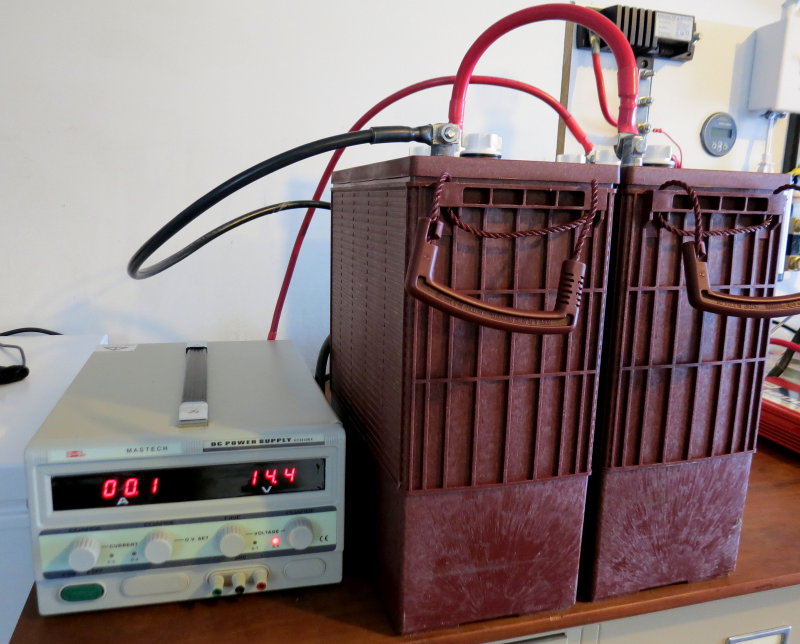Cruising Sailors Forum Archive
If it was simple for everyone I would not be working on boat electrical systems every day.... (wink)
Quote: "Boat electrical is so simple that I have trouble seeing how anyone could not understand it."
Was it not you who just said.....
"That said, their number is acceptable for summer use when self-discharge rates are much higher than in winter, particularly if the boat is down south, like in CT or NY where it gets way too hot."
I believe you said that in direct reference to the West Marine Advisor suggesting a panel with a current output of 1.5% of "C", in current, is safe without a controller.....
Can you do the math for me on the 390Ah battery bank below that only needs only 0.1A to maintain 14.4V? The amount of self discharge required to keep this bank in the safe zone, using the 1.5% of "C" in current, that you suggested was "acceptable" would be interesting to see. I would be curious to know what temp the batteries needed to be at to lose just 1 hours worth of output of a 100W panel let alone 3-4 hours per day at 5+A...
The math from above that you suggested is "acceptable" for NY & CT
1.5%, in current, of a 390Ah bank is a tad over a 100W solar panel if we use Impp. 1.5% of 390Ah in current is 5.8A. This will occur every day, not just once per month.....
When this bank is full it only needs 0.1A of current to maintain it at 14.4V. It requires significantly less current to maintain a float level voltage. Push the current higher than 0.1A and the voltage will climb.
Brand new 390Ah Trojan L-16's = 0.1A to maintain 14.4V when full.......(nl)
This is what I have on one of my chargers today.. It is a 7 year old bank of three, very healthy for their age, US Battery DCXC 31's for a total capacity of 375Ah's. This 375Ah bank currently only needs 0.4A to maintain 14.4V...

If I bump the voltage regulation to 15.1V the bank only accepts 0.6A to maintain 15.1V.... This is the same size bank the West Advisor suggests could take a 100W panel or 5.625A with no controller (1.5% of 375Ah's in current = 5.625A). I know from running hundreds of batteries through my shop, and watching them charge, that in the real world that these particular batteries, when full, will go over 14.4V if the current exceeds 0.4A. The actual acceptance rates of batteries when, held at absorption voltages, is extremely low.

My point is the same, people try to learn but the data and information, even from multiple sources used in the industry, don't agree on this subject.
Messages In This Thread
- Do folks remove electronics during winter storage?

- I used to take my electronics off, but...
- I do...
- I was always told yes
- I do this..
- What winter storage?

- Only what's not built-in
- No, batteries kept aboard too but trickle charged

- I leave my batteries on board too...
- In the end, they'll lose less than 10-20% charge if left alone, disconnected from any wiring. .


- Todd, curiosity about how many watts panels you rely upon for this.

- Sailboat with 500 amp-hours of battery capacity..
- Thanks.

- I have been tracking self discharge...

- Exactly, the decreased rate of self-discharge with decreased temp...
- Thanks.
- Sailboat with 500 amp-hours of battery capacity..
- In the end, they'll lose less than 10-20% charge if left alone, disconnected from any wiring. .
- I leave my batteries on board too...
- When it gets cold arn't you suppose
